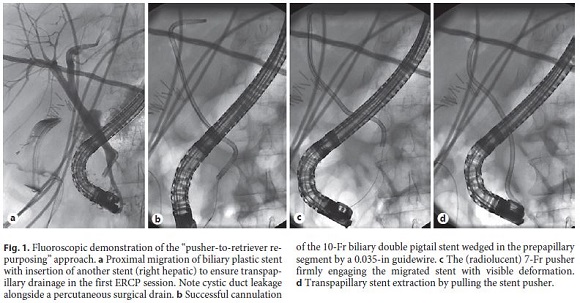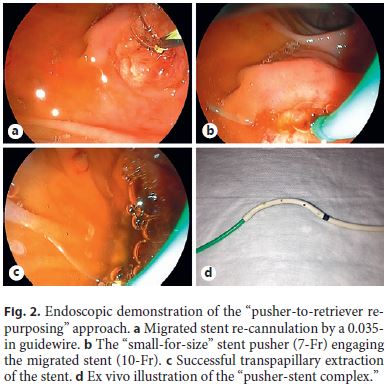Services on Demand
Journal
Article
Indicators
-
 Cited by SciELO
Cited by SciELO -
 Access statistics
Access statistics
Related links
-
 Similars in
SciELO
Similars in
SciELO
Share
GE-Portuguese Journal of Gastroenterology
Print version ISSN 2341-4545
GE Port J Gastroenterol vol.27 no.3 Lisboa June 2020
https://doi.org/10.1159/000503933
ENDOSCOPIC SNAPSHOT
“Pusher-To-Retriever Repurposing” as a Novel Endoscopic Bailout for Proximal Biliary Stent Migration
“Pusher-to-retriever repurposing” como uma nova solução endoscópica para a migração proximal de prótese biliar
Vincent Zimmera,b, Siegfried Exnera
aDepartment of Medicine, Marienhausklinik St. Josef Kohlhof, Neunkirchen, Germany; bDepartment of Medicine II, Saarland University Medical Center, Saarland University, Homburg, Germany
* Corresponding author.
Keywords: Endoscopic retrograde cholangiopancreatography, Stent migration, Endoscopic extraction, Endoscopy
Palavras-Chave: Colangiopancreatografia retrógrada endoscópica, Migração prótese, Extração endoscópica, Endoscopia
A 62-year-old patient presented for endoscopic retrograde cholangiopancreatography (ERCP) due to bile leakage with incipient biliary peritonitis after laparoscopic cholecystectomy. After biliary access, cholangiography confirmed cystic duct leakage, and biliary stenting using a 10-Fr (7 cm; Optimed, Ettlingen, Germany) double pigtail was performed after medium-size papillotomy. However, given a, in retrospect, too short stent length, the distal end of the stent became wedged into the pre-papillary common bile duct after release. Various attempts to extract the stent by baskets and/or foreign body forceps failed due to lack of maneuverability in this narrow operative field with a decision made to terminate the first ERCP session by transpapillary implantation of a longer 11-cm stent into the right hepatic system (Fig. 1a, note cystic duct leakage with surgical drainage and migrated stent in the left hepatic duct). In another ERCP session 2 days later and after successful stent re-cannulation (Fig. 1b, 2a), an over-the-wire snare approach likewise failed, such that we resorted to a “small-for-size” 7-Fr stent pusher (Optimed), being advanced deeply until dynamic cholangiography confirmed a tight connection to the variably deformed stent (Fig. 1c, 2b, note the radiolucent nature of the pusher). Next, the stent was extracted by pulling back the pusher (Fig. 1d, 2c). The intimate association of the “pusher-stent complex” is additionally illustrated ex vivo in Figure 2d. Finally, another sufficiently long stent with the same specifications as before (10-Fr, 11-cm; see Fig. 1a) was re-inserted, and re-ERCP scheduled 4 weeks later, according to standard proceedings in our center, with documentation of leakage closure.


There are myriad techniques available for proximal biliary stent migration both over-the-wire or freehand [1]. Here, a novel endoscopic bailout is introduced as “pusher-to-retriever repurposing” reminiscent of the Soehendra stent retriever approach, albeit associated with less costs and probably more widely available in endoscopy services.
References
1 Chaurasia OP, Rauws EA, Fockens P, Huibregtse K. Endoscopic techniques for retrieval of proximally migrated biliary stents: the Amsterdam experience. Gastrointest Endosc. 1999 Dec;50(6):780–5.
Statement of Ethics
Patient consent has been obtained.
Disclosure Statement
The authors have no conflicts of interest to report.
* Corresponding author.
Dr. Vincent Zimmer
Department of Medicine, Marienhausklinik St. Josef Kohlhof
Klinikweg 1–5
DE–66539 Neunkirchen (Germany)
E-Mail vincent.zimmer@gmx.de
Received: August 2, 2019; Accepted after revision: September 29, 2019














